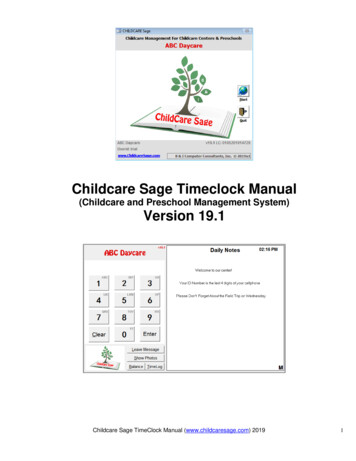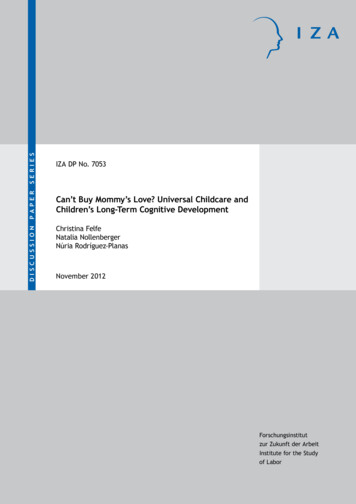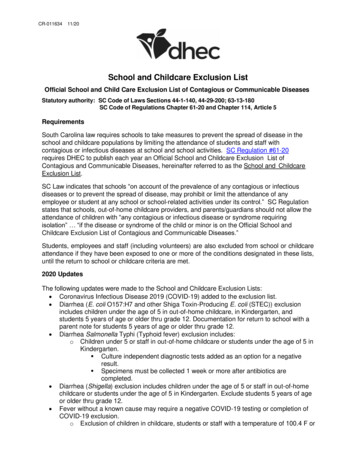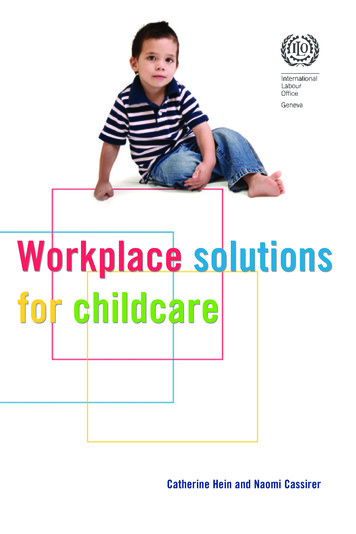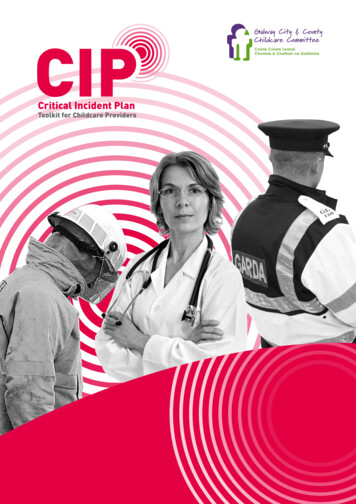
Transcription
CIPCritical Incident PlanToolkit for Childcare Providers
AcknowledgementsCritical Incident Plan – A Toolkit for Childcare ServicesThe Critical Incident Plan Toolkit was created in collaboration withtwelve partners in the childcare sector. Funding was granted throughthe Department of Children and Youth Affairs (DCYA) Central Fund andadministered by Pobal.The project steering group is greatly indebted to Margaret McHugh, who was contracted to research and developthe Critical Incident Plan: Toolkit for Childcare Services. Her clarity and vision resulted in a resource that is bothcomprehensive and user-friendly. Childcare providers, Norma Hanley and Anne Rabbitte, contributed valuablefeedback as members of the steering group. Feedback from childcare providers who responded to the questionnaire,as well as those who evaluated the plan just before it was finalised contributed greatly to the end product. FrankKavanagh, Senior Psychologist, National Educational Psychological Services (NEPS) generously shared his expertise inthe early stages of the project. Breda McCarthy, Team Leader, HSE Pre-school Services chaired the steering group andwas on hand to advise and support, as was Moira Culkin, Director of Nursing in Bon Secours Hospital and Galway City& County Childcare Committee Board Member. Rosario Ní Shúilleabháin Information Officer, Galway CCC was the CIPproject manager.Steering GroupBreda McCarthy (Chairperson)Early Years Manager, HSE WestMargaret McHughCritical Incident Response ConsultantMoira CulkinBoard Member, Director of Nursing Bon SecoursNorma HanleyManager, Childcare ServiceAnne RabbitteBoard Member & Manager, Childcare ServiceMary GiblinCoordinator, Galway CCCandAll staff of Galway City & County Childcare CommitteeProject PartnersBreda McCarthyEarly Years Manager, HSE WestKerstin MurrayChild Care Manager, HSE North TipperaryIrene CafferkyManager, Roscommon CCCJim PowerCoordinator, Mayo CCCGrainne McKennaCoordinator, Fingal CCCDara O’BrienCoordinator, Limerick City CCCSharon BolesCoordinator, Sligo CCCMuriel MartinCoordinator, Westmeath CCCMarie McArdleCoordinator, Longford CCCAileen HealyCoordinator, North Tipperary CCCJeremy KynastonCoordinator, Wicklow CCCTeresa HeeneyDirector of Services, Early Childhood IrelandIrene GunningChief Executive, Early Childhood IrelandPatricia MurrayChief Executive, Childminding Ireland
Table of ContentsPolicy Statement3Definition of a Critical Incident3Emergency Preparedness3Responsibilities and Roles in Emergency Planning and Response4Preparing the Emergency Preparedness Plan(s)6Development of Emergency Preparedness Plan(s)7Critical Incident Procedures8Communication with the Media9Business Continuity Planning10Evaluation and Review of Management Plan10AppendicesAppendix A) Sample Emergency Preparedness Risk Assessment11Appendix B) Sample Template for Emergency Contact List13Appendix C) Sample Evacuation Bag Content List14Appendix D) Sample Individual Emergency Preparedness Plans15Appendix E) Sample Critical Incident Action Guide17Appendix F) Emergency Operational Procedure & Time Log18Appendix G) Contacting Emergency Services – What to expect19Appendix H) Principles of Evacuation20Appendix I)21Principles of Lockdown or Sheltering on Site
CIPCritical Incident PlanToolkit for Childcare ProvidersIntroductionExpect the unexpected! Emergency situations usually come with little or no warning and often result in confusion anddevastation. The purpose of this toolkit is to address basic emergency planning and response for a range of childcareemergencies. The outcome of a critical incident is dependent on how well the people involved have planned andprepared for such occurrences.The aim is to create a sample critical incident response policy and procedure for childcare services allowing providers tohave the capacity to respond appropriately in the event of a critical incident; to return to normal as quickly as possibleafter the incident and to limit the effects of the incident on children; families; staff/committee and any parties affected bythe critical incident.The plan outlines the roles of childcare providers; staff; parents and the community in responding to an emergencysituation. All aspects, from identifying the risks to developing individualised emergency preparedness plans have beenconsidered. The templates in this booklet outline all the steps necessary so that providers can create a critical incidentplan to suit their own services. Consideration is given to the various types and sizes of childcare facilities and plansmay be designed and utilised by services ranging from large full day care services to childminders operating in theirown homes.Frank Kavanagh, Senior Psychologist, NEPS who was an adviser in the early stages of planning, highlighted that intimes of trauma and uncertainty children need to have familiar faces around them. Therefore, management and staffhave a key role to play when a critical incident occurs. Also, childcare services should, in the process of planning thecritical incident response, prioritise regular training drills so all staff are familiar with the process.A national training programme has been developed to assist childcare providers to customise their individual CriticalIncident Plans. Childcare Committees and National Voluntary Organisations will participate in the delivery of trainingnationwide.
1. Policy Statement5. EmergencyPreparednessEmergency situations usually come with little or nowarning and often result in confusion and devastation.Emergency preparedness is the preparation and planningThe outcome of a Critical Incident is dependent on hownecessary to effectively handle a critical incident. Itwell the people involved have planned and prepared forinvolves individuals assessing the likelihood of specificsuch occurrences. The purpose of this plan is to addresscritical incidents occurring and developing an emergencybasic emergency planning and response for a range ofplan that identifies the services they require, and thechildcare emergencies.resources they need to have on hand in case such anincident occurs. The goal of these preparedness activities2. Aimis to make sure that a facility is ready and able to respondThe aim of this plan is to provide guidance toAs a minimum, the following emergency situations shouldmanagement and staff of childcare services on thebe addressed:quickly and effectively in the event of a critical incident.prevention of and effective response to a critical incident. Medical EmergenciesThe purpose of this plan is to facilitate individual childcare Missing Childservices to: Natural Disasters: flood, storms, icy weather minimize the risks of a critical incident Utility Disruption, water, electricity, heatingoccurring; Fire/smoke Emergencies have an effective approach in responding to Hazardous Material; chemical spillscritical incidents as they occur; Potentially Violent Situations (unauthorized/ identify appropriate support and counsellingsuspicious person/intruder)structures in the event of an incident; Disgruntled or Impaired Parent/Guardian identify and implement appropriate trainingand information resources for staff. Bomb Threat Pandemic Flu or other Pandemic Episodes3. Scope Evacuation Process and Procedure forThis plan refers to all childcare facilities as defined in Gas leakSheltering Off-sitethe Child Care (Pre-School Services) (No 2) RegulationsChildcare facilities located in office buildings and other2006, Department of Health & Children and those Criticalshared space need to identify the emergency responseIncidents as defined in Section 4 and 5.coordinator for the building and coordinate the programs’1plans with the others involved. You will need to advocatefor the unique needs of children.4. Definition of CriticalIncidentA critical incident is any incident or sequence of eventswhich overwhelms the normal coping mechanisms of theschool2.1) Child Care (Pre-School Services) (No 2) Regulations 2006, Department of Health & ChildrenNational Educational Psychological Service (NEPS), ‘Responding to Critical Incidents, Guidelines for Schools’, Department ofEducation and Science, 20072)
CIPCritical Incident PlanToolkit for Childcare Providers6. Responsibilities and Roles in Emergency Planning andResponseA. The Childcare Provider/Manager/Person in Charge1) Ensures that the facility remains in compliance with Child Care (Pre-School Services) (No 2) Regulations 2006in regard to: First Aid Medical Assistance Management and staffing Registering of children Records Information for Parents Fire safety measures Premises and Facilities2) Develops with help from a planning team the facility Emergency Preparedness Plan(s).3) Trains staff and children in the provisions of Emergency Preparedness Plan(s).4) Assigns emergency responsibilities to staff members as required, with regard to individual capabilities andnormal responsibilities.5) Secures necessary training for staff members (as applicable).6) Conducts drills and initiates required plan revisions based on drill evaluations.7) Keeps parents and staff members informed of Emergency Preparedness Plan revisions.8) Supervises periodic safety checks of the physical facility, equipment and vehicles.B. The Facility Staff (as available)1) Participate in developing the facility’s Emergency Preparedness Plan(s).2) Participate in emergency preparedness training and drills.3) Help children develop confidence in their ability to care for themselves.4) Provide leadership during a period of emergency.C. Facility Maintenance Personnel (as applicable)1) Participate in developing the facility’s Emergency Preparedness Plan(s).2) Conduct periodic safety inspections of the facility.3) Identify shut-off valves and switches for gas, oil, water and electricity. Post a chart showing shut-offlocations so that others can use them in an emergency.4) Provide for emergency shut-off of the ventilating system(as applicable).5) Instruct all staff members on how to use fire extinguishers.
D. Facility Food Service Personnel (as applicable)1) Shall ensure that suitable, sufficient, nutritious and varied food is available at all times.2) Maintain adequate supplies of non-perishable food and water for emergency use.3) Rotate supplies to ensure freshness.E. Parents1) Become familiar with the Emergency Preparedness Plan(s) and procedures they are to follow.2) Know the procedures for picking up their children if an emergency causes the facility to relocate to anothersite.3) Ensure that the information the facility has on the children and parents is current and correct.4) Where appropriate, assist the facility manager in writing the plan.F. CommunityThe community, especially local government, can be a source of:a) Warningb) Emergency Resourcesc) InformationThis assistance should come primarily from:d) Government Departmentse) Emergency Medical Servicesf)Gardaí Siochánag) Fire Departmenth) Non-Governmental agenciesOther possible sources of assistance include:i)Individuals with relevant expertisej)Churchesk) Civic clubs and organizationsl)Businesses and industries
CIPCritical Incident PlanToolkit for Childcare Providers7. Preparing the Emergency Preparedness Plan(s)It is important that facilities have a comprehensive written plan with procedures to be followed when a Critical Incidentoccurs. The plan should be rehearsed periodically.Authority for the plan and its implementation should be established and the circumstances during which emergencyprocedures are to be followed must be identified. An awareness of the natural and human-caused hazards likely tooccur in a particular area and a thoughtful assessment of the facility and available resources - both material and human- are required.The first step is to identify those who will form the Critical Incident Management Team (CIMT). The team should includebut is not limited to the following: Critical Incident Team Leader/Childcare provider/Manager Senior staff members Local Garda(í) Health and Safety Representative Facilities Maintenance Manager Parent representative(s) Representative of local health services Psychologist Media liaisonIt is recognised that the constitution of a CIMT will depend on the size and complexity of the childcare facility. Insmaller facilities, there may be only one person to perform several of the roles outlined.7.1 The responsibilities of the team will include:a) Risk assessment of hazards and situations which may require emergency action and to which the facility maybe vulnerable (Appendix A);b) Analysis of requirements to address these hazards;c) Development of an emergency preparedness plan for each critical incident identified;d) Establishment of liaison with all relevant emergency services e.g. garda, fire brigade, ambulance, GP,community emergency services, hospital, poisons information centre, community health services;e) 24 hour access to contact details for all children and their families;f) 24 hour access to contact details for all relevant staff members needed in the event of a critical incident;g) Assisting with implementation of emergency preparedness plans;h) Dissemination of planned procedures;i) Organisation of practice drills;j) Coordination of appropriate staff development;k) Regular review of emergency preparedness plans.
8. Development of Emergency Preparedness PlansIn the development of specific emergency preparedness plans, it should be recognised that there will be some commonrequirements and each facility should, at a minimum, have the following as standard: A current list of staff members’ names, addresses and contact details for staff and next of kin; A current list of children including special needs requirements; An attendance log book; A current list of parents and second named guardian including contact details; Adequate first aid resources and a current list of staff with first aid training; A quick reference guide with contact details for the Critical Incident Team and essential services; (AppendixB) A clearly defined evacuation procedure which identifies pre-designated assembly areas and if required, arelocation shelter site; An evacuation bag (for suggested contents, see Appendix C); Up to date facility floor plans and maps outlining fire exits and location of essential services; Templates for communications with parents and the media (ref. Resource materials, Dept. of Education); Contact details for interpretive services if required; Maintaining a soft copy file of children’s photographs, with parental consent, should be considered.Emergency situations identified during risk assessment as being high risk to the facility should have a specific plandeveloped. These plans should be concise and consistent in their layout and format and should be in addition toorganisation policies and procedures required by laws and regulation.Each plan should identify:1) The hazards – list the dangers should this emergency arise;2) Preparedness – identify the measures in place to prevent this happening;3) Response – include the specific actions required with relevant contact details included;4) Recovery – outline the actions to be taken for recovery.Sample plans are included in Appendix D.
CIPCritical Incident PlanToolkit for Childcare Providers9. Critical Incident ProceduresWhen an incident occurs, staff will immediately alert the facility manager or designated person. It is the responsibility ofthe manager to determine whether the incident is deemed to be critical. The facility manager or designated person willlead the emergency response and be guided by the Critical Incident Action Guide (Appendix E).9.1 Immediate Response [within 24 hours]a) Identify the nature of the critical incidentb) Implement the appropriate emergency preparedness planc) Contact emergency servicesd) Delegate immediate first aid to trained staffe) If applicable, secure the areaf) Ensure safety and welfare of children and staffg) Notify the critical incident team leader if not on siteh) Liaise with emergency services, hospital and medical servicesi) Contact and inform parents and family membersj) Identify children and staff members most closely involved and at riskk) Manage media and publicityl) Maintain Emergency Operational Procedure & Time Log (Appendix F)9.1.1 Managing Stress Following a Critical IncidentInvolvement in, or exposure to, abnormal workplace incidents can lead a person to experience distress. It is normal toreact emotionally to a critical incident. It is important therefore that staff involved in a critical incident are kept informedand given the opportunity to rest and have time out from their routine duties following an incident.The manager/person in charge should consider the following strategies: Convene a meeting for those involved as soon as possible; Summarise the incident and clarify uncertainties; Invite questions and discuss issues of concern; Show care and support for the individual; Draw up a plan of action, taking into account the needs of staff; Make short-term arrangements for work responsibilities; Ensure that staff are happy to leave the facility and are escorted home if necessary; Seek expert advice on debriefing.
9.2 Secondary Response [24–72 hours]a) Assess the need for support and counselling for those directly and indirectly involved.b) Provide staff, parents and wider community with factual information as appropriate.c) Arrange debriefing for all parents, children and staff most closely involved and at risk.d) Restore the facility to regular routine, program delivery, and community life as soon as practicable.e) Complete critical incident report.9.3 Ongoing Follow-up Responsea) Identify any other persons who may be affected by the critical incident and provide access to supportservices for community members.b) Provide accurate information to parents and staff.c) Arrange a memorial service and occasional worship as appropriate.d) Maintain contact with any injured and affected parties to provide support and to monitor progress.e) Monitor staff and children for signs of delayed stress and the onset of post traumatic stress disorder;providing specialized treatment as necessary.f) Evaluate critical incident and Emergency management plan.g) Be sensitive to anniversaries.h) Manage any possible longer term disturbances e.g. inquests, legal proceedings.10. Communication with the MediaAt all times the CIMT must balance the need for clear and effective communication with the rights of those involved toprivacy. Where a critical incident involves issues of a sensitive nature, the team should agree on the information whichcan be disclosed and that which should only be disclosed on a need to know basis.Each facility should have clear direction for staff on who within the organisation can communicate with the media. Thenamed person should be in a position of authority and may include the facility manager or a representative of the boardof management.It is advised that a sample statement is agreed by the CIMT during the planning process.In the event of a critical incident it is very important that the CIMT agree the process for dealing with the media at anearly stage. This should include agreement on the following: The location for communication. Decide whether this is best suited onsite or offsite; The statement to be released. A sample announcement to the media is available in “Responding to CriticalIncidents, Resource Materials for Schools”, Department of Education and Science, 2007; Whether an interview should be given.Further guidance is available in ‘Responding to Critical Incidents, Guidelines for Schools’, Department of Education andScience, 2007.
CIPCritical Incident PlanToolkit for Childcare Providers11. Business Continuity PlanningBusiness Continuity Planning is working out how to continue operations under adverse conditions such as fires inbuildings and utility breakdowns, natural incidents like severe ice and floods, and national incidents like pandemicillnesses. In fact, any event that could impact operations should be considered, such as supply chain interruption, lossof or damage to critical infrastructure (major machinery or computing/network resource). Business Continuity Planningshould therefore be included in all emergency management risk assessment activities.12. Evaluation and Review of Management Plan1) After a critical incident, a meeting of the critical incident team will be held to evaluate the critical incidentreport, the effectiveness of the management plan and to make modifications as required.2) The evaluation process will incorporate feedback gathered from staff, parents and local communityrepresentatives3) An evaluation report will be made available to the management team.AppendicesA) Sample template for Emergency Risk AssessmentB) Sample template for Emergency Contact ListC) Suggested content for Evacuation BagD) Sample Individual Emergency Preparedness Plans – Severe Cold/Ice Missing Child/AbductionE) Sample Critical Incident Action GuideF) Emergency Operational Procedure & Time LogG) Contacting Emergency Services – What to ExpectH) Principles of EvacuationI) Principles of Lockdown or Sheltering on SiteReferences1) Child Care (Pre-School Services) (No 2) Regulations 2006, Department of Health & Children2) National Educational Psychological Service (NEPS), ‘Responding to Critical Incidents, Guidelines forSchools’, Department of Education and Science, 200710
Appendix ASample Emergency Preparedness Risk AssessmentINSTRUCTIONS:When conducting this risk assessment, you need to evaluate every potential event in each of the three categories oflikelihood, risk, and preparedness. Add or remove events as appropriate to your facility.Likelihood: Consider the following:1) Known risks2) Past events3) Manufacturer statisticsRisk: Consider the following:1) Threat to life and/or Health & Safety2) Disruption of services3) Possibility of failures4) Loss of community trust5) Financial impact6) Legal issuesPreparedness: Consider the following:1) What plans are in place2) How many staff are trained3) Insurance cover4) Availability of back-up systems5) Community resourcesFor each category assign the value that you believe accurately reflects the present situation.Multiply the ratings for each event in the area of likelihood, risk and preparedness. The total values, in descendingorder, will represent the events most in need of focus and resources for emergency planning. Determine a value belowwhich no action is necessary. Acceptance of risk is at the discretion of the organization.11
Appendix ACIPCritical Incident PlanToolkit for Childcare cy Preparedness Risk AssessmentEVENTSCOREHUMANBomb threatChild Abduction/Missing ChildCommunity DisasterMedical Emergency(Anaphylaxis, choking,fracture)ViolenceNATURALEpidemicLightning occurrenceSevere storm/floodingSevere cold conditionsWater contaminationTECHNICALElectrical FailureFire, InternalGenerator FailureHazmat ExposureHVAC FailureGas Leak/explosionTOTAL12
Appendix BEMERGENCY CONTACT LISTCRITICAL INCIDENT MANAGEMENT TEAMRoleNamePhone No. (Mobile)Phone No.DayNightDirector/ManagerStaff member 1Staff member 2H&S OfficerFacilities ManagerParent Representative 1Parent Representative 2PsychologistMedia ContactHealth ServicesLife-threatening or time-critical emergencyLocal Garda StationAmbulanceFire ServicesLocal DoctorHospital(s)ElectricityWater SuppliesGasPriest/Spiritual leaderCounty Childcare ServicesHSE Preschool servicesHealth & Safety AuthorityLocal Authority13999/112999/112999/112
CIPAppendix CCritical Incident PlanToolkit for Childcare ProvidersEmergency Evacuation Bag ChecklistKeep the Emergency Evacuation Bag in a designated, easily accessible place. It is advised that the bag should bedesigned to wear over the shoulder or on the back (rucksack) and should be a distinctive colour. The contents of thebag should be checked weekly.4Have you:Child DataChildren and staff with special needs listChild Release FormsStaff DataEmergency Contact ListTraffic safety vestsKeysStandard portable First Aid kit with bandages, Savlon, antiseptic wipesMedical and special needs list: children with asthma, allergies including specialmedications e.g. asthma inhalers, EpiPensA charged mobile phoneTorch with replacement batteries (or wind up torch)A megaphone/loudspeakerPortable battery powered radioBottled waterPortable non perishable snacks such as sultanas, dried fruits, energy barsCopy of facility site plan and evacuation routesToiletry supplies & sunscreenWhistlePlastic rubbish bags and tiesPortable DVD player & DVDsOther:14
Appendix DEMERGENCY PREPAREDNESS PLANEMERGENCY: Severe Cold/IceRISKS Damage to pipe work systems Damage to premises or plant items exposed Vehicle accident Slips and fallsPREPAREDNESS Frost protection system in place Heat sources near water tanks Sourcing of salt supplies in early Autumn Building is checked when unoccupied during cold spells Monitoring of weather forecasting First aid equipment on site Web texting in placeRESPONSE Respond to warnings received from media or local authorities Check facility systems, water, gas etc Check the building Contact maintenance re distribution of salt on all external pathways and driveways Assess Health & Safety risks –structures, sources of heat and/or watercompromised, grounds unsafe etc Risk assess the need for shutdown of services Use web texting for communication with parentsPlumber:Electrician:Facility manager:RECOVERY Full inspection of facilities and grounds Repair structures as necessary Liaise with parents in regard to restoration of services Review emergency preparedness plan15
CIPAppendix DCritical Incident PlanToolkit for Childcare ProvidersEMERGENCY PREPAREDNESS PLANEMERGENCY: Missing Child/Child AbductionRISKS Injury, trauma or death of a childPREPAREDNESS Security systems in place Up to date contact details for parents Registration and log in of all visitors CCTV monitoring Staff training Local protocol in place for field trips Local procedure in place for child collection Reference file of child photographs, updated annually Plan tested annuallyRESPONSE Confirm that the child is missing Ensure that all other children have been accounted for Conduct search of building and local area Inform facility manager/person in charge Call Emergency services – 999 or 112 Convene CIMT meeting Gather information to establish when and where the child was last seen Furnish Gardaí with photograph and accurate details of child’s age and what thechild was wearing Notify the child’s parents Refer media enquiries to the designated person Consider press release to local radio seeking assistance with advice from Gardaí Undertake search of the locality under the direction of the GardaíRECOVERY Establish the safety and wellbeing of the child when found Arrange child medical review Seek support from counselors where appropriate Conduct root cause analysis and review of systems Amend emergency preparedness plan as necessary Initiate new systems as appropriate16
Appendix ECRITICAL INCIDENT ACTION GUIDEEmergency Lead1. Ph:2. Ph:Immediate Responsibilities/ActionsRing 999 / 112Emergency ServicesPhone:GP:Delegate roles tosenior trained staffImmediate first aidOther:Contact CIMT membersInitials Airway Breathing CirculationContact1. Ph:Segregation of children2. Ph:3. Ph:4. Ph:5. Ph.Follow SpecificEmergencyManagement PlanConsider: Evacuation Lockdown Securing grounds Communication needs Locations for parents,media, briefings etc Shutting off systems Documentation of time lines Agreeing stand downSecondary Response Maintain the security of children & staff Maintain communication with emergency services, parents and media Assess need for support and counselling Arrange debriefing Inform regulatory bodies as appropriate:HSEHSACCCPublic HealthInsurance company Restore facility to regular routine as soon as possible Complete incident report Evaluate, review and if necessary amend the Emergency Management Plan17
CIPAppendix FCritical Incident PlanToolkit for Childcare ProvidersEMERGENCY OPERATIONAL PROCEDURE & TIME LOGEmergency:Time of Initiation:Issues to Be AddressedDate:Time of Stand down:TimeCommentsCoordinator identifiedCIMT members contactedInitiate appropriate emergency preparedness planAssess child/staff safetyOutside sources to be contactedGardai/Ambulance/Fire BrigadeWill evacuation/lock down be requiredActivate fire alarmDo children need to move to relocation site?Add food supplies to evacuation bagDelegation of duties to Staff First aid Segregation of children Services need to be isolated Are all entrances secure Front door Emergency exits Assistance required for evacuation Secure SiteHave off duty staff to be contacted?Do parents need to be contacted?Do services need to be cancelledOrganize for collection of childrenConsider impact on electricity supplyConsider impact on gas supplyConsider impact on water supplyConsider impact on other servicesConsider impact on securityIs there an Infection risk?Are there P.R. issues to be addressedInvolve commercial servicesLocate supply of specialist equipmentLocate approved subcontractorsRecord specialist contractor contact detailsEmergency lead calls stand downAll Parties informed of stand downCo-ordinator Signature:Date:Copies of report to: Board of Management, CIMT members18
Appendix GContacting Emergency Services –
the early stages of the project. Breda McCarthy, Team Leader, HSE Pre-school Services chaired the steering group and was on hand to advise and support, as was Moira Culkin, Director of Nursing in Bon Secours Hospital and Galway City & County Childcare Committee Board Member. Rosario Ní Shúilleabháin Information Officer, Galway CCC was the CIP


